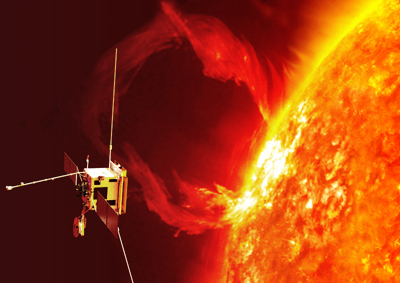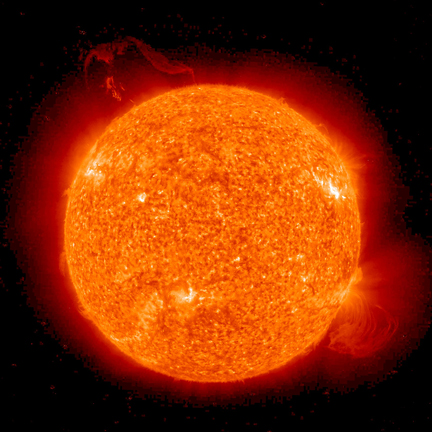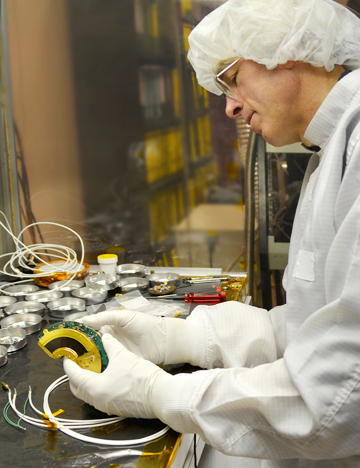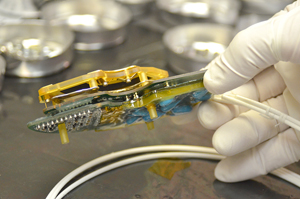Fall 2012
SINCE THE DAWN of the space age, scientists and engineers in the Space Science Center have been highly successful designing and building instruments for satellites that help solve fundamental mysteries of the universe and push the bounds of discovery forward.
 |
|
| Artist's depiction of Solar Orbiter exploring the sun's realm. © ESA/AOES. |
This has led to a heritage of in-house expertise and the ability to craft similar instrumentation for successive missions with related science goals. Indeed, a telescope currently being developed for the Solar Orbiter mission is based on one built at UNH and currently aboard NASA's twin Solar-Terrestrial Observatory (STEREO) spacecraft.
The Solar Orbiter telescope will do work similar to its predecessor, but will do so under much more stressful conditions; it will have to sweat it out in a region where spacecraft temperatures reach 500 degrees Fahrenheit, squint at light 13 times more intense than at Earth, and withstand highly energetic particles able to go through metal as if it was butter.
 |
|
| Pieces of the sun's outer atmosphere were flung into space as the STEREO spacecraft observed in extreme ultraviolet light from November 23-25, 2010. Photo courtesy of NASA. |
"That's one of the biggest challenges for this mission," says research professor Antoinette Galvin, who leads the UNH team developing the Ion Composition Time-of-Flight/Energy Telescope that will be part of the Heavy Ion Sensor. The work is being done under a $4.67 million subcontract from the Southwest Research Institute (SwRI)—lead institution for the sensor aboard the joint European Space Agency/NASA mission. Professor Lynn Kistler is a co-investigator and is responsible for making sure all UNH hardware is designed to meet mission science requirements.
The UNH telescope is not an optical telescope but, rather, a detector that can measure individual, high-energy particles. It's at the very heart of the mission because it will measure—closer to the source than ever before—the particles that explode directly off the sun to create the million-mile-per-hour solar wind, which in turn creates the "space weather" conditions that can have profound effects on society.
"Most of the orbiter's instrumentation will be behind a state-of-the-art heat shield, but because we have to look directly at the sun and measure these particles, part of our telescope will actually reside in an area cut from the main heat shield specifically for this purpose," says Galvin.
The instrument, in other words, will occupy the hot seat for the entire seven-year mission. A miniature heat shield will afford additional protection, but the telescope aperture must be fully exposed to the elements. Galvin adds, "This is new territory as far as radiation and heat and even just the photo flux, or how brilliant it will be. The closer you are to the sun, the more intense it gets in terms of the number of particles, and we have to worry about the lifetime of our detector because the very thing we measure can destroy it."
During periods of its elliptical orbit, Solar Orbiter will be closer to the sun than Mercury, which has a sun-facing surface temperature of 800 degrees Fahrenheit. That's getting into the range of a self-cleaning oven, which essentially cremates whatever's inside.
Close in to "pristine" particles
Solar Orbiter, which is set to launch in 2017, will address today's central heliophysics question: how does the sun create and control the heliosphere—the immense magnetic bubble containing our solar system, solar wind, and the entire solar magnetic field.
To uncover the mysteries, in situ measurements of the solar wind plasma, fields, waves, and energetic particles have to be made close enough to the sun so that they are still relatively pristine and have not had their properties modified by subsequent transport and propagation processes.
Moreover, to get a true measure of the pristine nature of these phenomena, the spacecraft needs to find a perch at least 30 degrees above the ecliptic plane in which the planets orbit the sun.
"A lot of what we observe is within the ecliptic or planetary plane. This is where the majority of our spacecraft are located," Galvin says.
But not everything originates in that narrow band. For example, plasma, particles, and processes can come from regions at high latitudes and get pushed down to the ecliptic.
"And we know this is occurring because we've been able to make observations with STEREO imaging," adds Galvin—the principal investigator for the Plasma and Suprathermal Ion Composition instrument on the STEREO mission.
To get into an orbit above the ecliptic plane, the spacecraft will do a series of Venus fly-bys over a period of years using the planet's gravity to hurl itself ever closer to the sun and achieve progressively higher latitudes.
 |
|
| Mark Popecki inspects a prototype particle detector in a Space Science Center cleanroom. Photo by Kristi Donahue, UNH-EOS. |
Being high up and close in as never before will provide scientists with the best view for looking at the evolution of the sun's phenomena and the origin of the solar wind.
Says Galvin, "By the time we see the solar wind it has been processed and changed by interactions in space, and one thing we're trying to uncover is how the solar wind originates and is released. Being closer in with Solar Orbiter, we should be able to more clearly pinpoint what part of the sun is releasing the solar wind in the first place."
The UNH-designed telescope will make direct measurements of the pristine materials the solar wind is made of—carbon, oxygen, silicon, iron, etc., which in turn will help identify the source region. By having higher spatial and temporal resolution (being close to the source) combined with imagery provided by other onboard instruments, "means we'll be able to link things together without having to worry how much they changed before our instrument saw it," Galvin says.
Built to last
Being a mere 21 million miles from the sun (that's 71,960,000 miles closer than is Earth), the engineering of Solar Orbiter has to be otherworldly indeed. And that presents a challenge to Space Science Center mechanical engineer John Nolin in particular.
Working with thermal engineers at SwRI, Nolin has to figure out the best means of building the instrument to withstand both punishing heat and radiation. This entails weighing the options between heat- and radiation-resistant materials versus cost and mass.
 |
|
| The particle detector shown from below. Photo by Kristi Donahue, UNH-EOS. |
"Radiation-hardened parts are more expensive and usually bigger," notes Galvin, "but we only have so much space on board the spacecraft so we have to be creative."
Nolin notes the spacecraft's heat shield, which will always face the sun, is nearly a foot thick and built of multiple, composite layers of metals, and heat-resistant coatings."
"This will take the brunt of it and the heat will just spill around the edges," Nolin says. "It's kind of like skipping a stone on a pond where you're kicking up a wave and the water's splashing all around you. So, we're on the backside of the stone."
Even though it will be in the hot seat in the cutaway portion of the main heat shield, the instrument's internal temperature is expected to get no higher than 86 degrees Fahrenheit thanks to it's own smaller heat shield for all but the telescope's aperture.
"That's as hot a temperature as our electronics will face, and it's the electronics—circuit boards and such—that have to be protected from the heat and radiation," Nolin says. "A lot of what's being measured requires highly specific timing in the electronics to identify one element from another and the energies of incoming particles, and heat and radiation can cause electronics to behave differently and alter the measurements."
Nolin notes that even though the UNH-built telescope stands on the shoulders of work done previously by Space Science Center scientists and engineers, every new mission requires numerous modifications to attain the science goals at hand. This is achieved by stepping through a rigorous series of design reviews before actual flight instruments can be built and tested. The project is currently in the preliminary design phase with the first prototype instrument parts being fabricated.
In addition to Nolin, team members include research project engineers Chris Bancroft on electronics, David Heirtzler on telescope design and system engineering, senior research scientist Mark Popecki as instrument scientist, John Gaidos on test support electronics, and Jim Tyler as instrument manager. Also participating are Stan Ellis, Steve Turco, Jon Googins, Todd Jones, Keven Mello, Kristin Simunac, and Aaron Bolton. UNH student interns Anne Lamontagne, James Kilpeck, and Benjamin Kramer are assisting in the design and testing.